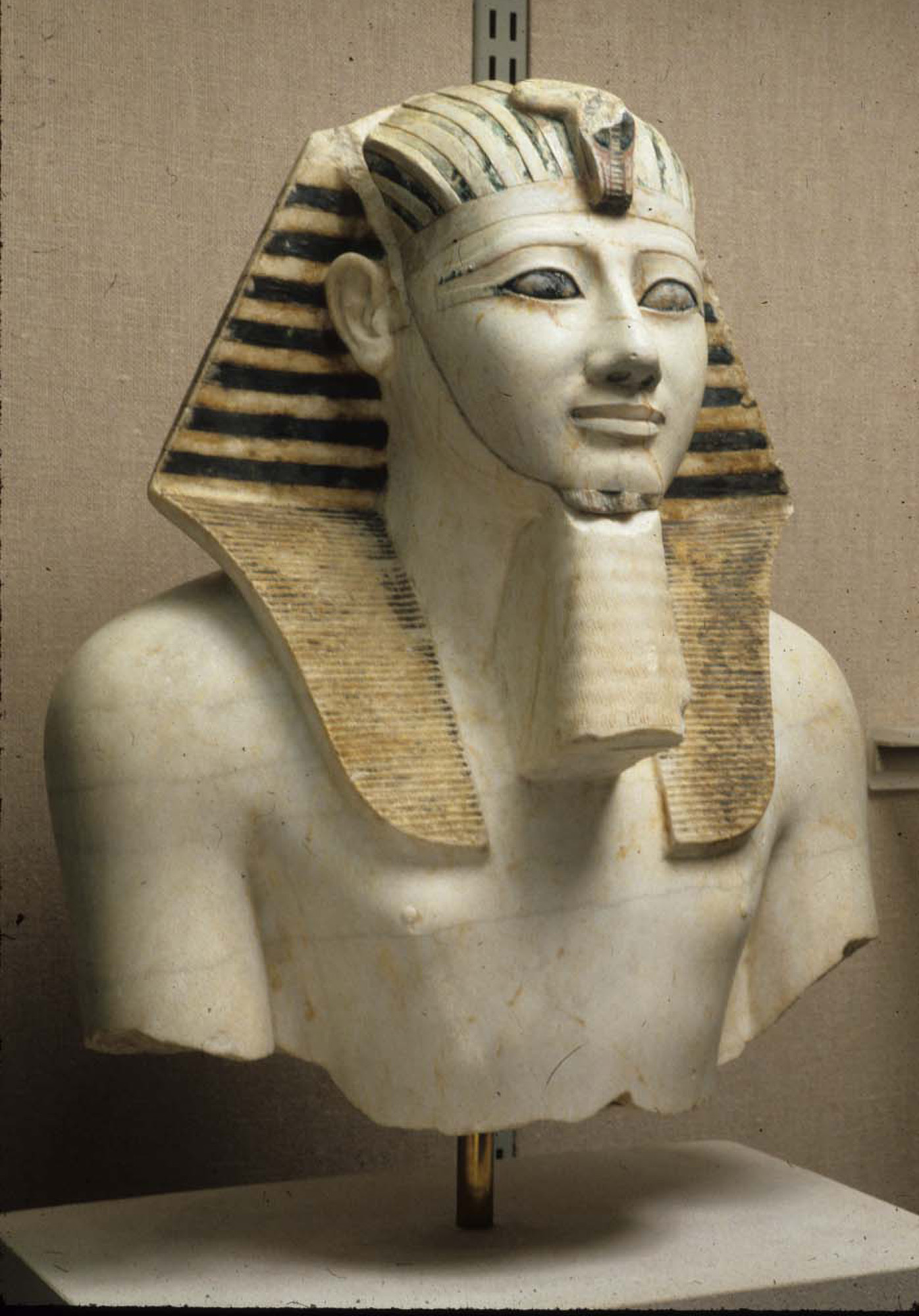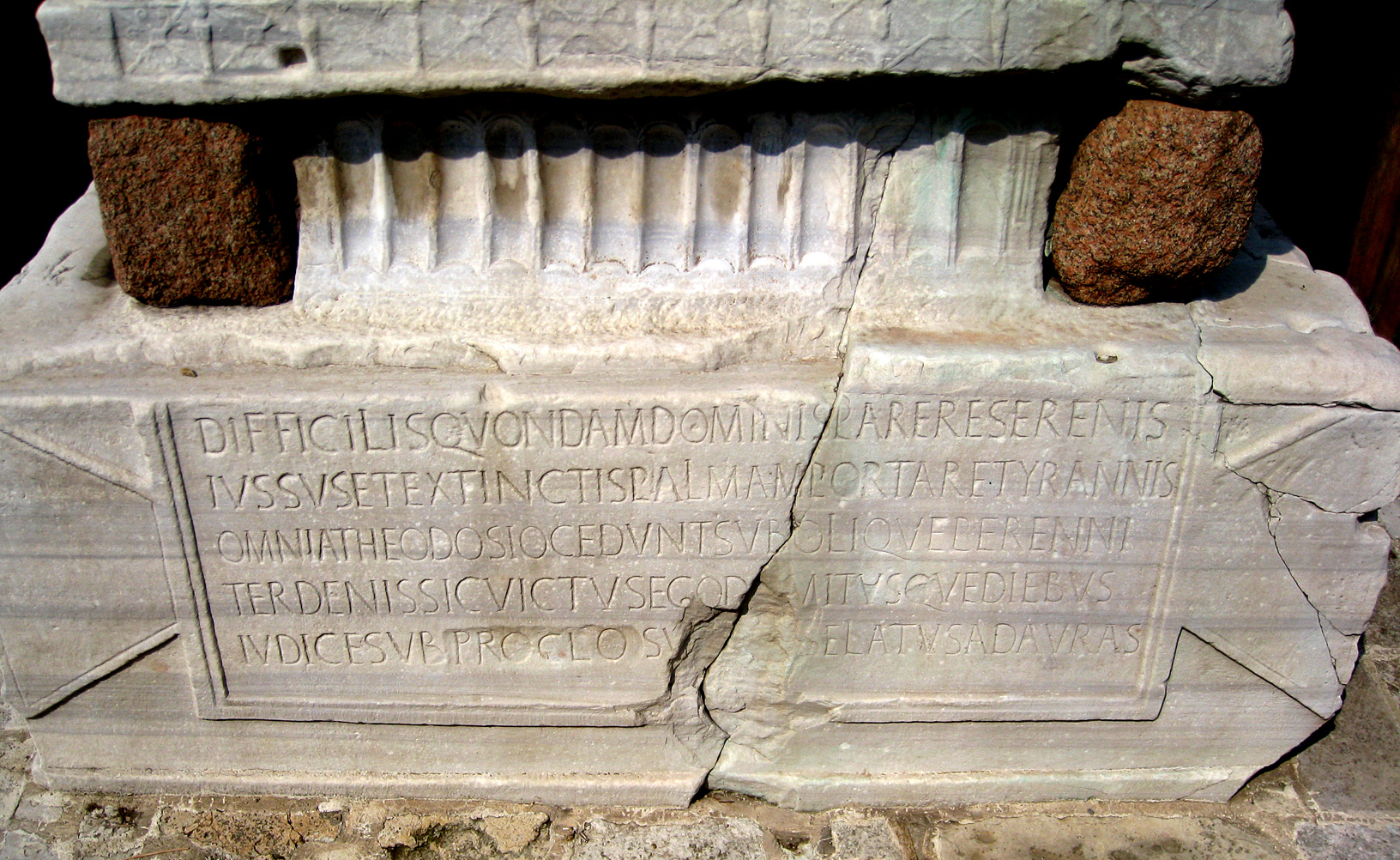|
Thutmose III Of Egypt
Thutmose III (variously also spelt Tuthmosis or Thothmes), sometimes called Thutmose the Great, was the sixth pharaoh of the Eighteenth Dynasty. Officially, Thutmose III ruled Egypt for almost 54 years and his reign is usually dated from 28 April 1479 BC to 11 March 1425 BC, from the age of two and until his death at age fifty-six; however, during the first 22 years of his reign, he was coregent with his stepmother and aunt, Hatshepsut, who was named the pharaoh. While he was shown first on surviving monuments, both were assigned the usual royal names and insignia and neither is given any obvious seniority over the other. Thutmose served as the head of Hatshepsut's armies. During the final two years of his reign, he appointed his son and successor, Amenhotep II, as his junior co-regent. His firstborn son and heir to the throne, Amenemhat, predeceased Thutmose III. He would become one of the most powerful pharaohs of the 18th dynasty. Becoming the sole ruling pharaoh of the ... [...More Info...] [...Related Items...] OR: [Wikipedia] [Google] [Baidu] |
Amarna Letters
The Amarna letters (; sometimes referred to as the Amarna correspondence or Amarna tablets, and cited with the abbreviation EA, for "El Amarna") are an archive, written on clay tablets, primarily consisting of diplomatic correspondence between the Ancient Egypt, Egyptian administration and its representatives in Canaan and Amurru kingdom, Amurru, or neighboring kingdom leaders, during the New Kingdom, spanning a period of no more than thirty years between c. 1360–1332 BC (see Amarna letters#Chronology, here for dates).Moran, p.xxxiv The letters were found in Upper Egypt at el-Amarna, the modern name for the ancient Egyptian capital of ''Akhetaten'', founded by pharaoh Akhenaten (1350s–1330s BC) during the Eighteenth Dynasty of Egypt. The Amarna letters are unusual in Egyptological research, because they are written not in the language of ancient Egypt, but in cuneiform, the writing system of ancient Mesopotamia. Most are in a variety of Akkadian language, Akkadian sometim ... [...More Info...] [...Related Items...] OR: [Wikipedia] [Google] [Baidu] |
Ramesses II
Ramesses II ( egy, wikt:rꜥ-ms-sw, rꜥ-ms-sw ''Rīʿa-məsī-sū'', , meaning "Ra is the one who bore him"; ), commonly known as Ramesses the Great, was the third pharaoh of the Nineteenth Dynasty of Egypt. Along with Thutmose III he is often regarded as the greatest, most celebrated, and most powerful pharaoh of the New Kingdom of Egypt, New Kingdom, itself the most powerful period of Ancient Egypt. The name ''Ramesses'' is pronounced variously . Transliteration of Ancient Egyptian, Other spellings include Rameses and Ramses; in grc-koi, Ῥαμέσσης, Rhaméssēs. He is known as Ozymandias in Greek sources ( grc-koi, Ὀσυμανδύας, translit=Osymandýas), from the first part of Ramesses's regnal name, , "The Maat of Ra is powerful, Chosen of Ra". His successors and later Egyptians called him the "Great Ancestor". At age fourteen, he was appointed prince regent by his father, Seti I. Most Egyptologists today believe he assumed the throne on 31 May 1279 BC, bas ... [...More Info...] [...Related Items...] OR: [Wikipedia] [Google] [Baidu] |
Valley Of The Kings
The Valley of the Kings ( ar, وادي الملوك ; Late Coptic: ), also known as the Valley of the Gates of the Kings ( ar, وادي أبوا الملوك ), is a valley in Egypt where, for a period of nearly 500 years from the 16th to 11th century BC, rock-cut tombs were excavated for the pharaohs and powerful nobles of the New Kingdom (the Eighteenth to the Twentieth Dynasties of Ancient Egypt). The valley stands on the west bank of the Nile opposite Thebes (modern Luxor), within the heart of the Theban Necropolis.Siliotti (1997), p.13 The wadi consists of two valleys: the East Valley (where the majority of the royal tombs are situated) and the West Valley (Valley of the Monkeys). With the 2005 discovery of a new chamber and the 2008 discovery of two further tomb entrances, the valley is known to contain 63 tombs and chambers (ranging in size from KV54, a simple pit, to KV5, a complex tomb with over 120 chambers). It was the principal burial place of the major royal ... [...More Info...] [...Related Items...] OR: [Wikipedia] [Google] [Baidu] |
Upper Nubia
Upper Nubia is the southernmost part of Nubia, upstream on the Nile from Lower Nubia. It is so called because the Nile flows north, so it is further upstream and of higher elevation in relation to Lower Nubia. The extension of ''Upper Nubia'' is rather ill-defined and depends on the researchers’ approach. Geographical approach Geographically speaking ''Upper Nubia'' designs the area between the Second and the Sixth cataracts of the Nile. Occasionally the term ''Middle Nubia'' is used to design the area between the Second and the Third cataract; in this case ''Upper Nubia'' begins at the Third cataract going upstream. Physiographic subdivisions of Upper Nubia alongside the Nile cataracts: Political approach Politically speaking ''Upper Nubia'' falls in present northern and central Sudan stretching from the Egyptian border south to present-day Khartoum at the confluence of White Nile and Blue Nile.Barbara Ann Kipfer; Upper Nubia in: Encyclopedic Dictionary of Archaeology; 2000; ... [...More Info...] [...Related Items...] OR: [Wikipedia] [Google] [Baidu] |
Syria
Syria ( ar, سُورِيَا or سُورِيَة, translit=Sūriyā), officially the Syrian Arab Republic ( ar, الجمهورية العربية السورية, al-Jumhūrīyah al-ʻArabīyah as-Sūrīyah), is a Western Asian country located in the Eastern Mediterranean and the Levant. It is a unitary republic that consists of 14 governorates (subdivisions), and is bordered by the Mediterranean Sea to the west, Turkey to the north, Iraq to the east and southeast, Jordan to the south, and Israel and Lebanon to the southwest. Cyprus lies to the west across the Mediterranean Sea. A country of fertile plains, high mountains, and deserts, Syria is home to diverse ethnic and religious groups, including the majority Syrian Arabs, Kurds, Turkmens, Assyrians, Armenians, Circassians, Albanians, and Greeks. Religious groups include Muslims, Christians, Alawites, Druze, and Yazidis. The capital and largest city of Syria is Damascus. Arabs are the largest ethnic group, and Mu ... [...More Info...] [...Related Items...] OR: [Wikipedia] [Google] [Baidu] |
Coregency
A coregency is the situation where a monarchical position (such as prince, princess, king, queen, emperor or empress), normally held by only a single person, is held by two or more. It is to be distinguished from diarchies or duumvirates such as ancient Sparta and Rome. Co-principality is a distinct but related system employed in contemporary Andorra, where monarchical power is formally divided between two rulers. Historical examples Coregencies were common in the Hellenistic period; according to one scholar, they "can usually be explained as a means of avoiding crises of succession or internal conflict, and of strengthening dynastic identity and ideology." Other examples include the coregency of Frederick I of Austria and Louis the Bavarian over the Kingdom of Germany. ''Jure uxoris'' Kings in Kingdoms such as Spain and Portugal can also be found (Ferdinand V and Isabella I of Castile, Philip I and Joanna of Castile, Peter III and Maria I of Portugal, etc.). In Navarre, ... [...More Info...] [...Related Items...] OR: [Wikipedia] [Google] [Baidu] |
Egypt
Egypt ( ar, مصر , ), officially the Arab Republic of Egypt, is a transcontinental country spanning the northeast corner of Africa and southwest corner of Asia via a land bridge formed by the Sinai Peninsula. It is bordered by the Mediterranean Sea to the north, the Gaza Strip of Palestine and Israel to the northeast, the Red Sea to the east, Sudan to the south, and Libya to the west. The Gulf of Aqaba in the northeast separates Egypt from Jordan and Saudi Arabia. Cairo is the capital and largest city of Egypt, while Alexandria, the second-largest city, is an important industrial and tourist hub at the Mediterranean coast. At approximately 100 million inhabitants, Egypt is the 14th-most populated country in the world. Egypt has one of the longest histories of any country, tracing its heritage along the Nile Delta back to the 6th–4th millennia BCE. Considered a cradle of civilisation, Ancient Egypt saw some of the earliest developments of writing, agriculture, ur ... [...More Info...] [...Related Items...] OR: [Wikipedia] [Google] [Baidu] |
Pharaoh
Pharaoh (, ; Egyptian: ''pr ꜥꜣ''; cop, , Pǝrro; Biblical Hebrew: ''Parʿō'') is the vernacular term often used by modern authors for the kings of ancient Egypt who ruled as monarchs from the First Dynasty (c. 3150 BC) until the annexation of Egypt by the Roman Empire in 30 BC. However, regardless of gender, "king" was the term used most frequently by the ancient Egyptians for their monarchs through the middle of the Eighteenth Dynasty during the New Kingdom. The term "pharaoh" was not used contemporaneously for a ruler until a possible reference to Merneptah, c. 1210 BC during the Nineteenth Dynasty, nor consistently used until the decline and instability that began with the Twenty-Fifth Dynasty. In the early dynasties, ancient Egyptian kings had as many as three titles: the Horus, the Sedge and Bee ( ''nswt-bjtj''), and the Two Ladies or Nebty ( ''nbtj'') name. The Golden Horus and the nomen and prenomen titles were added later. In Egyptian society, religio ... [...More Info...] [...Related Items...] OR: [Wikipedia] [Google] [Baidu] |
Obelisk Of Theodosius
The Obelisk of Theodosius ( tr, Dikilitaş) is the Ancient Egyptian obelisk An obelisk (; from grc, ὀβελίσκος ; diminutive of ''obelos'', " spit, nail, pointed pillar") is a tall, four-sided, narrow tapering monument which ends in a pyramid-like shape or pyramidion at the top. Originally constructed by An ... of Pharaoh Thutmose III re-erected in the Hippodrome of Constantinople, Hippodrome of Constantinople (known today as ''At Meydanı'' or ''Sultanahmet Meydanı'', in the modern city of Istanbul, Turkey) by the Roman Empire, Roman emperor Theodosius I in the 4th century AD. History The obelisk was first erected during the Eighteenth Dynasty of Egypt, 18th dynasty by Pharaoh Thutmose III (1479–1425 BC) to the south of the seventh pylon (architecture), pylon of the great Karnak, temple of Karnak. The Roman emperor Constantius II (337–361 AD) had it and another obelisk transported along the river Nile to Alexandria to commemorate his ''ventennalia'' or 20 ye ... [...More Info...] [...Related Items...] OR: [Wikipedia] [Google] [Baidu] |
Cleopatra's Needle
Cleopatra's Needles are a separated pair of ancient Egyptian obelisks now in London and New York City. The obelisks were originally made in Heliopolis (modern Cairo) during the New Kingdom period, inscribed by the 18th dynasty pharaoh Thutmose III and 19th dynasty pharaoh Ramesses II. They were later moved to the Caesareum of Alexandria, which had been conceived by Ptolemaic Queen Cleopatra VII, for whom the obelisks are named. They stood in Alexandria for almost two millennia until they were re-erected in London and New York City in 1877 and 1881 respectively. Together with Pompey's Pillar, they were described in the 1840s in David Roberts' '' Egypt and Nubia'' as " hemost striking monuments of ancient Alexandria". The removal of the obelisks from Egypt was presided over by Isma'il Pasha, who had greatly indebted the Khedivate of Egypt during its rapid modernization. The London needle was presented to Great Britain in 1819, but remained in Alexandria until 1877 when Sir Will ... [...More Info...] [...Related Items...] OR: [Wikipedia] [Google] [Baidu] |






